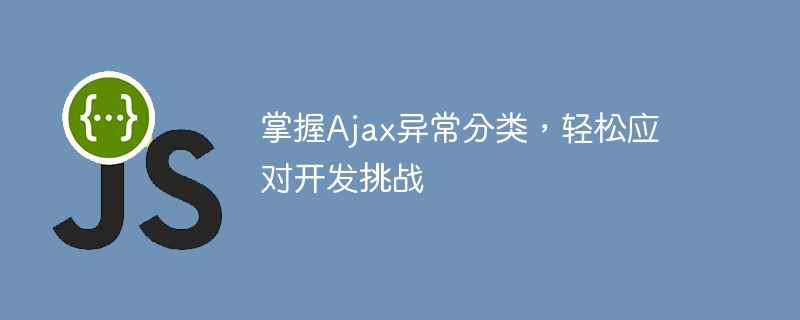

Master Ajax exception classification and easily cope with development challenges. Specific code examples are required
In modern web development, Ajax (Asynchronous JavaScript and XML) technology has become indispensable missing part. With Ajax, we can update part of the content through asynchronous requests without reloading the entire page, improving user experience and page performance. However, during the development process, we often face the challenge of various Ajax request exceptions. In order to better deal with these problems, this article will introduce some common Ajax exception classifications and corresponding solutions, and provide specific code examples.
1. Network exception
When making an Ajax request, the most common problem is network connection failure. This may be due to network instability, server failure, or problems with the browser itself. To deal with this situation, we can handle exceptions by catching the error event.
Here is a simple code example:
$.ajax({
url: "example.php",
dataType: "json",
success: function(response) {
// 请求成功
},
error: function(xhr, status, error) {
// 处理网络连接失败的情况
}
});Sometimes, due to network latency or high server load, Ajax requests may will time out. In order to solve this problem, we can set the timeout parameter to limit the time of the request. When the request times out, the exception can be handled through the error event.
The sample code is as follows:
$.ajax({
url: "example.php",
dataType: "json",
timeout: 5000, // 设置超时时间为5秒
success: function(response) {
// 请求成功
},
error: function(xhr, status, error) {
// 处理请求超时的情况
}
});2. Server-side exception
When an exception occurs on the server side , usually returns an error status code. We can judge what error occurred based on the status code and handle it accordingly.
The following is a sample code for handling 404 errors:
$.ajax({
url: "example.php",
dataType: "json",
success: function(response) {
// 请求成功
},
error: function(xhr, status, error) {
if (xhr.status == 404) {
// 处理404错误
} else {
// 处理其他错误
}
}
});Sometimes, the server will return some error information so that We diagnose and fix problems better. We can get the returned error information through xhr.responseText.
The sample code is as follows:
$.ajax({
url: "example.php",
dataType: "json",
success: function(response) {
// 请求成功
},
error: function(xhr, status, error) {
var errorMessage = xhr.responseText;
// 处理错误信息
}
});3. Data processing exception
When the data returned by the server cannot be parsed When doing this, we need to handle data parsing errors. A common situation is that the data returned by the server is not in the format we expect (for example, HTML is returned instead of JSON). In order to deal with this situation, we can use the try-catch statement to catch parsing exceptions and handle them accordingly.
The sample code is as follows:
$.ajax({
url: "example.php",
dataType: "json",
success: function(response) {
try {
var parsedData = JSON.parse(response);
// 处理解析后的数据
} catch (error) {
// 处理数据解析错误
}
},
error: function(xhr, status, error) {
// 处理其他错误
}
});Sometimes, although the data returned by the server is parsed successfully, it may contain business logic mistake. In order to deal with this situation, we can determine whether the returned data meets our expectations in the callback function, and perform specific processing on the non-conforming data.
The following is a sample code:
$.ajax({
url: "example.php",
dataType: "json",
success: function(response) {
if (response.errorCode === 0) {
// 处理业务逻辑正常的情况
} else {
// 处理业务逻辑异常的情况
}
},
error: function(xhr, status, error) {
// 处理其他错误
}
});The above are some common Ajax exception classifications and corresponding response plans. By mastering this knowledge, we can more effectively deal with abnormal situations during development and improve application stability and user experience. Hope the above content is helpful to you!
The above is the detailed content of Easily master Ajax exception classification to meet development challenges. For more information, please follow other related articles on the PHP Chinese website!
 What system is qad?
What system is qad?
 How to solve dns failure
How to solve dns failure
 How to deal with garbled Chinese characters in Linux
How to deal with garbled Chinese characters in Linux
 What does frame rate mean?
What does frame rate mean?
 The difference between access and trunk ports
The difference between access and trunk ports
 How to connect broadband to server
How to connect broadband to server
 How to open state file
How to open state file
 Can Douyin sparks be lit again if they have been off for more than three days?
Can Douyin sparks be lit again if they have been off for more than three days?




